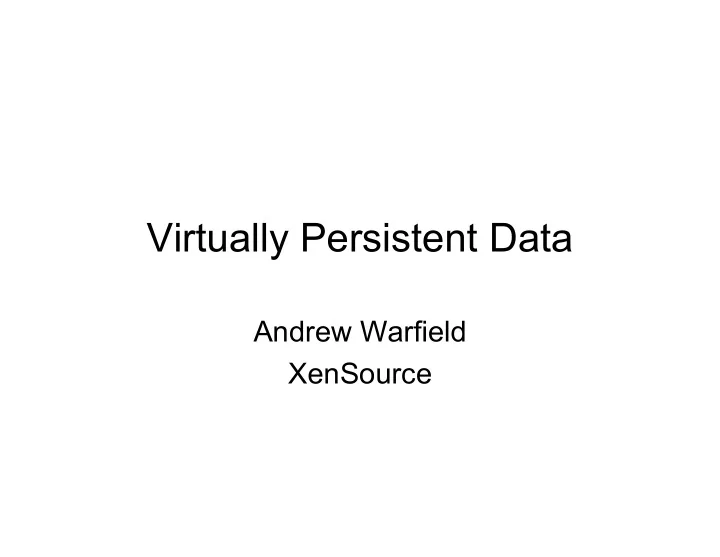

Virtually Persistent Data Andrew Warfield XenSource
Quick Overview • Blktap driver overview/update – Performance vs. Safety – Architecture – Tapdisks • Block consistency and live migration – Problem, current solution, future solution
Why BlkTap? • It turns out that performance isn’t the only requirement for VM storage. • Other requirements: – Correctness – Managability (e.g. file-based disks) – Crazier things (CoW/encryption/network) • Doing these things at the Linux block layer is tricky.
Example: blkback + loopback Dom0 DomU blkback blkfront disk Example 1: Normal block device operation. • Go through safety concerns, mention fix in loopback2, also mention qos/block shed issues.
Example: blkback + loopback Dom0 DomU blkback blkfront disk Example 1: Normal block device operation. • Blkback preserves the semantics of the physical disk. • DomU is notified of completion once data is really written.
Example: blkback + loopback Dom0 DomU OOM Killer nfs loop blkback blkfront Example 2: Loopback and NFS • New loopback driver should fix this. • Associating requests with a process has qos/sheduling benefits.
Architecture Blktapctrl tapdisk tapdisk Each tapdisk process handles requests for a VBD. Blktap Blkfront Blkfront Dom0 DomU DomU • Blktap handles IDC • Tapdisk implements a virtual block device – Synchronous, AIO, QCoW, VMDK, Shared mem • Zero-copy throughout • Tapdisks are isolated processes
Current tapdisks • Individual tapdisk drivers may struct tap_disk be implemented as plugins. tapdisk_aio = { • Generally a few hundred lines "tapdisk_aio", of code. sizeof(struct • Very similar to qemu’s block tdaio_state), plugins, but with an tdaio_open, asynchronous interface. tdaio_queue_read, • Currently have asynchronous tdaio_queue_write, raw (device or image file), tdaio_submit, QCoW, VMDK, and shared- memory disks. tdaio_get_fd, tdaio_close, tdaio_do_callbacks, };
Blktap Performance
CoW/Image formats • Many image formats now exist for block devices – QCoW, VMDK, VHD • Work a lot like page tables: mapping tree for block address resolution – Typically use a bitmap at the bottom level • Ensuring consistency adds overhead – Metadata is dependent on data – Must be written before acknowledging request to DomU • We are currently working with a modified version of the QCoW format – 4K blocks, all-at-once extent allocation, bitmaps.
Migration Consistency Dom0 DomU Dom0 W W W W blkfront W W Host A Host B • Drivers use request shadow rings to handle migration • Unacked requests are reissued on arrival • Slight risk of write-after-write hazard. • Now fixed, more optimal plan for later.
What’s next? • Copy on Write • Live snapshots • Maybe some network-based/distributed storage.
end
Performance(2)
Recommend
More recommend